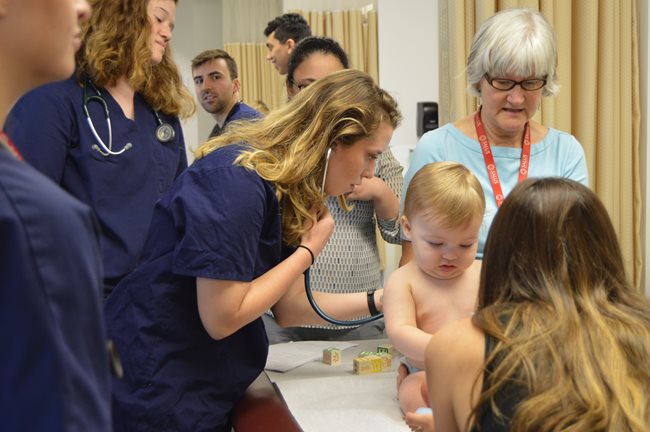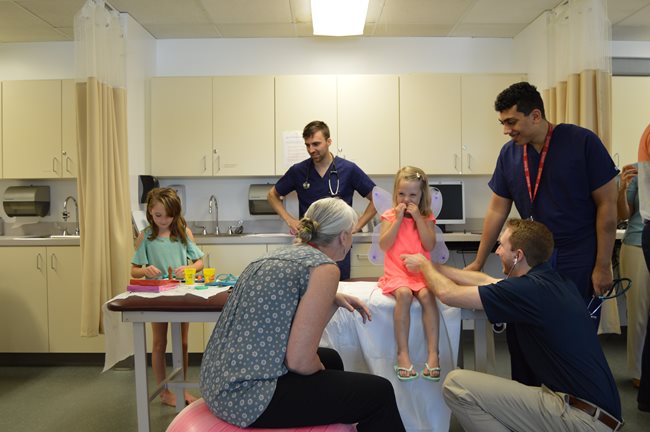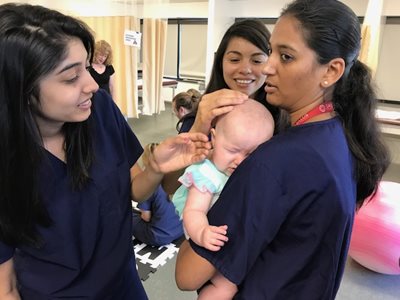
“You can feel free to make some fun noises if you need to as a means of distraction,” Dr. Margaret Mulligan, associate professor in the College of Health Sciences, said as she attempted to examine the symmetry of baby Martin’s wriggling legs.
A group of Physician Assistant (PA) Studies students smiled and let out a few audible “Aws” as Martin began to squirm. Dr. Mulligan was demonstrating the proper examination technique for an infant exam during the PA program’s well-child exam lab. Dr. Mulligan explained the importance of checking for symmetry through the body, measuring the child’s head circumference, examining alertness and performing the typical vital checks of the eyes, ears, chest and abdomen.
The workshop was developed to provide initial exposure to the pediatric patient population for the PA students prior to the start of their clinical rotations in September. The workshop afforded the opportunity to perform age-appropriate history and physical examinations, assess developmental milestones and practice providing anticipatory guidance to parents. Shad Crapo ’18PA said the immersive workshop was helpful when preparing for actual patients.
“It’s different when we talk about it in class than when we get hands-on experience,” he said. “Depending on the age of the child, we’re looking at the level of their developmental and cognitive skills.”
Dr. Mulligan emphasized to the observing class the importance of establishing and building trust with patients, especially as children mature. She chatted with a 10-year-old patient about what sports she plays and how she likes school prior to performing an older child model exam. She asked the patient if she had any issues with friends or classmates at school and reinforced that she should always talk to her mom or someone about what’s going on in her life.

The class mirrored the same holistic care approach as they broke into small groups to examine healthy children from infancy to age 10 using the American Academy of Pediatrics’ guidelines for examinations. One group chatted animatedly with a 6-year-old girl wearing butterfly wings about their favorite types of cereal, while another cheered on their patient hula hooping after her exam was complete.
Gina Costroff ’18PA said the lab was good way to understand the unique challenges children present while performing exams, prior to embarking on clinical rotations.
“You can’t always do things in the order you’d like because you just follow the child’s lead,” she said. “Whatever mood they’re in, that’s how you have to approach it.”
 Dr. Mulligan explained PAs do more than just examine a patient’s physical health; they look for outlying issues within the patient’s or family’s life in order to provide comprehensive, quality-based care.
Dr. Mulligan explained PAs do more than just examine a patient’s physical health; they look for outlying issues within the patient’s or family’s life in order to provide comprehensive, quality-based care.
“We will sometimes look for red flags such as the child who doesn’t seem to be interested in mom or a mom who does not appear engaged with the baby, especially, during that first year of life,” she said. “At the well-child initial visits, we’re really looking at attachment and evaluating mom as well – are there problems breastfeeding? Any evidence of post-partum depression, marital stressors, or is the family struggling to put food on the table?”
According to Donna Agnew, MSPAS, PA-C, DFAAP, PA program director, maternal-child health is complex and demands that a clinician maintain active listening skills and keen intuitiveness as well as clinical medical expertise.
“As clinicians, we need to adjust and accommodate the needs of our patients,” she said.